Radiological Society of North America :Researchers have found significant abnormalities in the eyes of some people with severe COVID-19.Of 129 COVID-19 patients in the study, nine had nodules in the macular region, the area in the back of the eye responsible for our central vision, with eight of them having nodules in both eyes.This is the first time these findings have been described using MRI.
Researchers using MRI have found significant abnormalities in the eyes of some people with severe COVID-19, according to a study published in the journal Radiology. The study results support the need for eye screening in these patients to provide appropriate treatment and management of potentially severe ophthalmological manifestations of COVID-19.






